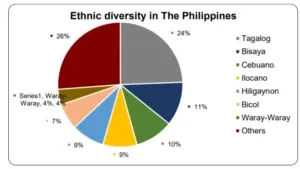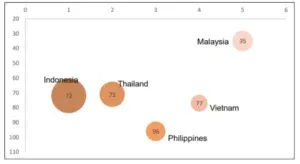Population – As the second most populous country in ASEAN, Philippines’ population exceeded 110 million people in the year 2020. This also made Philippines one of the most populous countries in Asia, and in doing so, afforded it a launch pad for future economic growth. The growth of the country’s population, however, has been slowing over the years with the latest annual growth rate standing at 1.3%. Still, with a high labor force participation rate of nearly 59.5%, Philippines has a pool of 46 million people to offer companies doing business in the country. Like Indonesia, Philippines, too, is an archipelago, and as such, its population is spread across the more than 7100 islands that together constitute the country. The geographic spread of Philippines’ population can be seen in the image below:

Religious and ethnic diversity –The Philippines is home to several different religions but Christianity, in its various forms, is undoubtedly the primary religion practiced in the country. Roman Catholicism alone is professed by nearly 80% of the Filipino population with another 5% collectively adhering to Evangelicalism and Inglesia ni Cristo. The second most prominent religion is Islam, but it is practiced by only 6% of the country’s people. As in many countries, religion is an important part of societal life in The Philippines and exercises influence on culture as well.

Ethnic diversity, too, is an undeniable characteristic of The Philippines. The ancestors of the vast majority of the population were of Malay descent and came from the Southeast Asian mainland as well as from what is now Indonesia. Contemporary Filipino society consists of nearly 100 culturally and linguistically distinct ethnic groups. Of these, the largest are the Tagalog of Luzon and the Cebuano of the Visayan Islands. Other prominent groups include the Ilocano of northern Luzon and the Hiligaynon (Ilongo) of the Visayan islands of Panay and Negros. The ethnic diversity in The Philippines, as depicted in the chart below, helps in creating a rich, multi-faceted culture with a unique flavor of its own.

To read more about ethnic and religious diversity in Philippines, follow the link below:
https://www.britannica.com/place/Philippines/Plant-and-animal-life#ref23729
Age – Philippines’ demographic advantage also stems from its fairly young population. According to the CIA, over 58% of the county’s population is estimated to be under the age of 30. This not only offers a substantial labor force to companies in the present day, but also extends positive future prospects of economic growth. Many countries today are bracing themselves for the future ramifications of an ageing population, but the Philippines is not among them, and that works in favor of long-term economic activity in the country.
Literacy Rate (% of people ages 15 and above) – 96%
Quality of Infrastructure Ranking – Infrastructure in the Philippines is yet to reach a level of sophistication that warrants comparison to other leading emerging markets. As displayed in the graph below, the Philippines’ Quality of Infrastructure ranking is far below those of its regional peers. However, steady progress is being made on this front and the Philippines’ ranking is on an upward trajectory, having gone up by 17 spots since 2017. As the country’s infrastructure continues to improve, it will be better placed to mobilize its resources in a manner that will spur further economic growth.
